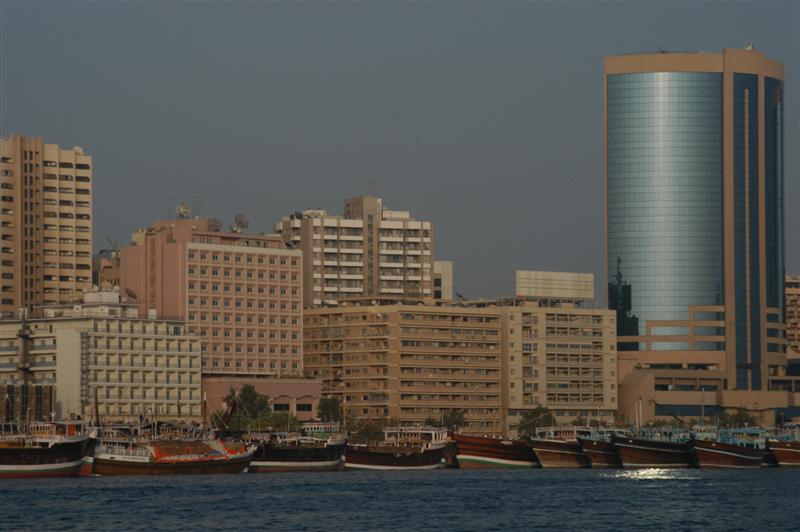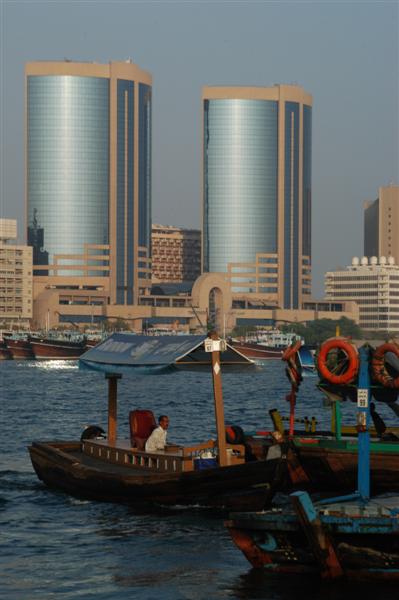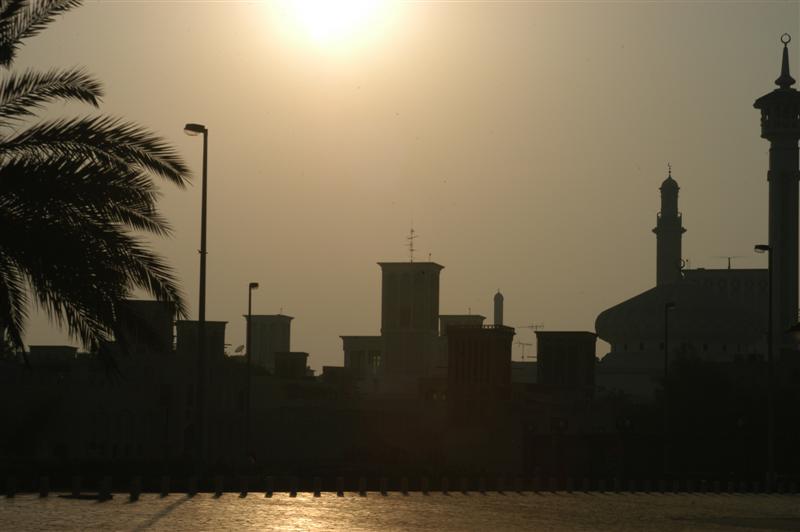October 18 - October 19. DUBAI During our time in Dubai we went through many changes in our plans. We thought  we'd found a cheap flight to the Maldives but we couldn't get a response from the hotels in time to book the flight. One minute Air Emirates had a cheap flight to Sri Lanka and the next minute it was gone, then it went up again. Each time we called it seemed like the airfare changed. We couldn't pay for a flight with a credit card so we had to go in to the office to actually buy the ticket. In the end we didn't buy a ticket. The rental car reservation was similarly challenging. There was a special rate posted on the Internet but could only secured if we reserved via the Internet. So, we logged on and made an Internet reservation and then had to call to sort out the details. The good thing was that they agreed to drop the car off at the hostel at no extra charge. We decided to leave on the 20th to tour the Emirates and just hoped we could get a airplane ticket sorted out when we got back. we'd found a cheap flight to the Maldives but we couldn't get a response from the hotels in time to book the flight. One minute Air Emirates had a cheap flight to Sri Lanka and the next minute it was gone, then it went up again. Each time we called it seemed like the airfare changed. We couldn't pay for a flight with a credit card so we had to go in to the office to actually buy the ticket. In the end we didn't buy a ticket. The rental car reservation was similarly challenging. There was a special rate posted on the Internet but could only secured if we reserved via the Internet. So, we logged on and made an Internet reservation and then had to call to sort out the details. The good thing was that they agreed to drop the car off at the hostel at no extra charge. We decided to leave on the 20th to tour the Emirates and just hoped we could get a airplane ticket sorted out when we got back.
Now that we were on the clock we decided we had to get out and see more of Dubai's cultural attractions. Who knew how much time we would have when we got back. The top things on our list were to visit the souks, the Dubai Museum and the Burj Al Arab Hotel. The museum was on the south side of Dubai Creek in Bur Dubai. We took a taxi to get there. As we sped down the side of the creek the midday sun was reflecting nicely against a row of glistening mirrored buildings, making a shimmering effect across the creek. Traditional style boats plied the creek and created a contrasting atmosphere to modern Dubai. reflecting nicely against a row of glistening mirrored buildings, making a shimmering effect across the creek. Traditional style boats plied the creek and created a contrasting atmosphere to modern Dubai.
The museum was housed in a on old fort, the Al-Fahidi fort, that was built in the early 19th century and is thought to be Dubai's oldest building. It was a small museum but well laid out and very informative. Around the fort courtyard the museum housed a collection of khanjars (curved daggers), a barasti house with a wind tower, and a display of traditional music instruments. None of this area was enclosed so it was getting rather hot when we discovered the entrance to the more modern section of the museum. A door led down a spiral ramp to a subterranean area, fortunately air-conditioned, that extended beneath the fort. It started with a good overview of Dubai's history, showing the Emirate's rise from a traditional community only about a half century ago to a today's modern manifestation. The rest of the area walked us through some detailed diorama of a traditional neighborhood with the old souk and homes. It created a nice atmosphere but there was a lot of reading at each exhibit that, while informative, became tiring towards the end. The exhibit ended with a display about the natural habitat, a small archeological room, and the obligatory gift shop. Packing with a lot of information for a little museum it was just the right amount to take in during a single museum visit.
From the museum we walked a couple of blocks to the Bastakia Quarter, a historical part of the city with preserved traditional buildings. Built at the turn of the century the old wind-tower homes belonged to wealthy Persian merchants that were lured to Dubai for commerce. Most came from the Bastakia region in southern Iran, giving the Dubai district its name.  The wind-tower architecture provided a form of air-conditioning that cooled the homes by funneling air in from above and down into the house. The Bastakia Quarter is protected and restoration work was still being done. Some of the buildings looked occupied but it was totally serene when we walked through the neighborhood. We only met a couple of other people as we wandered the narrow alleyways and took pictures of the wind towers. It was was mall place and we quickly came out the back side, near the river, and turned north until we came to a large mosque. A group of men where busy preparing for the evening meal in the front courtyard, dishing rice out of a large bowl. We smiled and nodded, they smiled back. The wind-tower architecture provided a form of air-conditioning that cooled the homes by funneling air in from above and down into the house. The Bastakia Quarter is protected and restoration work was still being done. Some of the buildings looked occupied but it was totally serene when we walked through the neighborhood. We only met a couple of other people as we wandered the narrow alleyways and took pictures of the wind towers. It was was mall place and we quickly came out the back side, near the river, and turned north until we came to a large mosque. A group of men where busy preparing for the evening meal in the front courtyard, dishing rice out of a large bowl. We smiled and nodded, they smiled back.
Returning down the river we left Bastakia and came out onto a creek front promenade. There we took a closer look at life on the creek as people began to take boats down river or just across the river to go home. We stood and watched the activity for a while. Since we arrived in Dubai I couldn't help but make a comparison between the city and Hong Kong. Natives of Dubai and Hong Kong may fail to see the relationship like a western tourist but on some levels there were common elements. The two cultures are so vastly different but for the western minded traveler they both evoked a feeling of the exotic "Orient" with lively markets, unfamiliar but delicious aromas, and colorful splashes of ornate carpets and other traditional accents, all a with particular attention to detail. It is difficult to put into words but there is a general taste and texture to the cities that distinctly separated them from cities in Europe, North America or Australia. Dubai and Hong Kong also share coastal locations with dramatic waterways and a modern backdrop of tall buildings. On the bay of Hong Kong you still see the occasional junk boat sail by and it Dubai Creek there are is the odd Dhow boat. And, they each have economic roots in trade. All that said, the differences are significant. The bustling energy of Hong Kong is a contrast to the more mellow tone of Dubai. The more extroverted culture of the Cantonese with their sing song tonal language is very different from the more hidden and introverted culture of Dubai with the hushed Arabic language. Hong Kong had its lush green hills as opposed to Dubai's stark desert landscape and lengthy beaches. Indeed they are very different places but the similarities still kept resurfacing in my mind. particular attention to detail. It is difficult to put into words but there is a general taste and texture to the cities that distinctly separated them from cities in Europe, North America or Australia. Dubai and Hong Kong also share coastal locations with dramatic waterways and a modern backdrop of tall buildings. On the bay of Hong Kong you still see the occasional junk boat sail by and it Dubai Creek there are is the odd Dhow boat. And, they each have economic roots in trade. All that said, the differences are significant. The bustling energy of Hong Kong is a contrast to the more mellow tone of Dubai. The more extroverted culture of the Cantonese with their sing song tonal language is very different from the more hidden and introverted culture of Dubai with the hushed Arabic language. Hong Kong had its lush green hills as opposed to Dubai's stark desert landscape and lengthy beaches. Indeed they are very different places but the similarities still kept resurfacing in my mind.
Although it was late afternoon it was still quite hot and we were both dying for some water. We walked along the river until we felt it getting close to sun down and we needed to grab a cab if we were to make it to the Burj Al Arab in time to see the sun set. Since it was approaching sunset we expected our cabbie to be flying down the coast to get us dropped off so he could go eat but this fellow, surprisingly, wasn't in such a hurry. The hotel was much farther than it looked on the map and the ride ended up costing about $25 or $30. The slower pace would have been more enjoyable if it weren't getting so close to sunset. We passed the large Jumeira Mosque, its coral facade lit in a rosy gold from the afternoon sun. Finally, after what felt like forever, the Burj came into view, perched on its own little island in front of the large Jumeira Beach Hotel, the wave hotel. We had the taxi pull over to a beach front road just north of the hotel so we could watch the sunset before it was too late. down and we needed to grab a cab if we were to make it to the Burj Al Arab in time to see the sun set. Since it was approaching sunset we expected our cabbie to be flying down the coast to get us dropped off so he could go eat but this fellow, surprisingly, wasn't in such a hurry. The hotel was much farther than it looked on the map and the ride ended up costing about $25 or $30. The slower pace would have been more enjoyable if it weren't getting so close to sunset. We passed the large Jumeira Mosque, its coral facade lit in a rosy gold from the afternoon sun. Finally, after what felt like forever, the Burj came into view, perched on its own little island in front of the large Jumeira Beach Hotel, the wave hotel. We had the taxi pull over to a beach front road just north of the hotel so we could watch the sunset before it was too late.
* * * *
(continued) |
DUBAI
I: Oct 15-17
II: Oct 15-17
I: Oct 18-19
II: Oct 18-19
AL AIN
Oct 20
Buraimi
(Oman)
Oct 21
OTHER
EMIRATES
Oct 22
ABU DHABI
Oct 23-24 |

